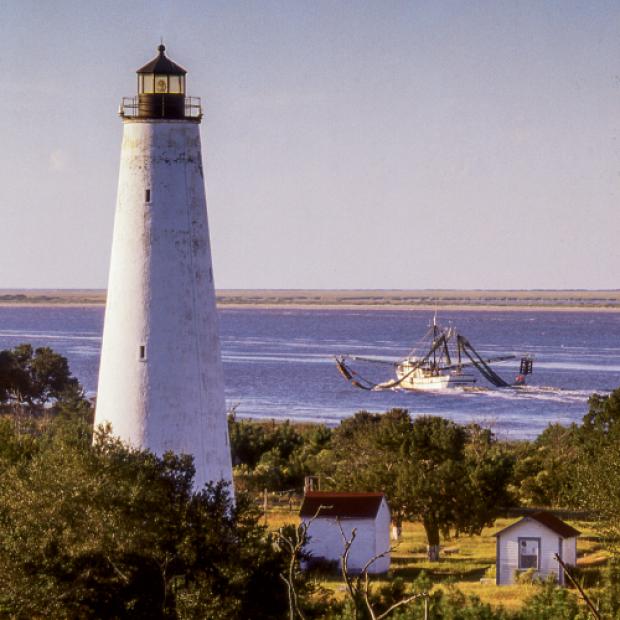
A drive through Georgetown offers views of warehouse structures and smoke stacks from the steel mill with logging trucks and the aroma of the International Paper mill. But if you stay a while, you will uncover a waterfront neighborhood of homes on the U.S. National Register of Historic Places, streets enveloped by ancient live oak trees, one-of-a-kind boutiques that offer designer clothes and unique gifts, and more delicious places to dine than your palate has time to feast!
History
Georgetown is the third-oldest city in South Carolina and has the second-oldest seaport. Take a tour of the city with Swamp Fox Tours (tours begin with warmer weather, mid-February or mid-March) to learn about the area’s antebellum homes, the South Carolina Champion Oak Tree estimated to be over 500 years old, South Carolina’s oldest African American A.M.E. Church and the fire on Front Street that destroyed eight structures of the historic waterfront. A vacant landscape of rubble, a slight smell of burnt wood, and a sense of solemnity still hang over the 700 block as clean-up continues a year later. Fortunately many of the affected businesses have relocated on Front Street for you to visit after the tour. 814 Front St.
Visit The South Carolina Maritime Museum for free. It showcases the 5th order Fresnel lens used for more than 125 years in the Georgetown Lighthouse, a.k.a. the North Island Lighthouse, which is located about 14 nautical miles from historic downtown Georgetown and is South Carolina’s oldest operating lighthouse. Subjects of exhibits include Georgetown’s history as a leading seaport in the 19th and early 20th centuries and shipbuilding with area cypress and live oak. The museum hosts a “Burning of the Socks” event in March which invites you to burn your winter socks in celebration of the upcoming spring. 729 Front St.
Learn about the Gullah people who played an integral part in American history at The Gullah Museum. Listen to Andrew Rodrigues as he discusses slave contributions—such as knowledge of rice and indigo farming—to South Carolina through Vermelle “Bunny” Rodrigues’s Story Quilts. Bunny’s Story Quilts are prized collectibles; her Michelle Obama Quilt is currently displayed in the Smithsonian Institute for its African American Museum. Free to visit. 123-7 King St.
Tour The Kaminski House Museum and neighboring Stewart-Parker House—the only historic houses open to the public. Tours guide you through life in Georgetown and showcase 18th and 19th century English and American antiques and architecture. A restored exterior of the Kaminski House debuts this Spring. 1003 Front St.
Good Eats
Georgetown has a myriad of options for fabulous local places to dine. Lands End Restaurant offers casual fine dining with unparalleled views of Winyah Bay. The restaurant is known for its fresh seafood (shrimp and grits is a specialty). 444 Marina Drive.
The Humble Crumb is a family-owned cafe and pizzeria known for its fresh, local ingredients and homemade foods. 2521 Highmarket St.
In the mood for barbeque? Check out Big Bill’s Lowcountry Barbeque, where you’ll find a buffet with all the barbeque and fixin’s your heart desires! 2041 N Fraser St.
Of course, Front Street offers numerous wonderful dining options as well. Enjoy the views of this waterfront community by visiting River Room, which sits on the Sampit River and offers views of the harbor. They proudly serve “Serious Seafood” in a casual atmosphere and offer an extensive wine list. 801 Front St.
Rice Paddy is a family-owned restaurant that has served generations of Georgetown locals and visitors. Enjoy the beautiful view of the river while dining on unique and elegant seafood, or try a more traditional dish (non-seafood is served as well). 732 Front St.
There are so many dining options on Front Street, you’re sure to discover something delicious while shopping or during a stroll on the scenic Harborwalk.
Things to Do
Shop Front Street. The Harbor Shop offers designer fashions, maritime code flag and mermaid décor. 714 Front St.
Bienvenue Home delights the senses with chic home décor and gifts. 814 Front St. Georgetown Art Gallery showcases original artwork from 20 talented local artists. 705 Front St.
Clock Tower Books is a hidden treasure of works for locals and by locals. 105 Screven St.
Stop by Hobcaw Barony, an internationally known ecological center for education, conservation and research. Visit its Discovery Center to learn about the history and ecology of its 16,000 acres—spanning the 18th, 19th and 20th centuries. Learn about native plants and animals and discover how you can help preserve their local habitats. Free. 22 Hobcaw Road off of U.S. 17.
Enjoy a community theater production by the Swamp Fox Players; view an independent film, foreign film or documentary at their Strand Cinema. 710 Front St.
Discover East Bay Park’s large playground, picnic tables and tennis courts. Launch your boat at East Bay Street Landing or make your way to Morgan Park and hike the trails for breathtaking views of the waterway. 310 Greenwitch Dr.
Catch a game of the International Paper Baseball Classic at Mike Johnson Park, named by Diamond Prospects as the #1 high school baseball facility in South Carolina in 2012. A replica of its original 1900s scoreboard was rebuilt in left field, where the numbers for the inning-by-inning scores are still hung by hand. Tournament March 5–8. www.ipclassic.com. 1500 Emanuel St.
Did you know?
•Georgetown was chosen as an All-America County and was listed as one of America’s Top 100 Small Towns
•Parts of The Patriot movie were shot at Mansfield Plantation in Georgetown County and the character Benjamin Martin, played by Mel Gibson, was loosely based on the legend of South Carolina’s “Swamp Fox:” Francis Marion
•The grandfather of First Lady Michelle Obama was originally from Georgetown
•The mother of comedian Chris Rock lives in Georgetown
•By the 1840s, almost half the rice consumed in the United States was grown around Georgetown